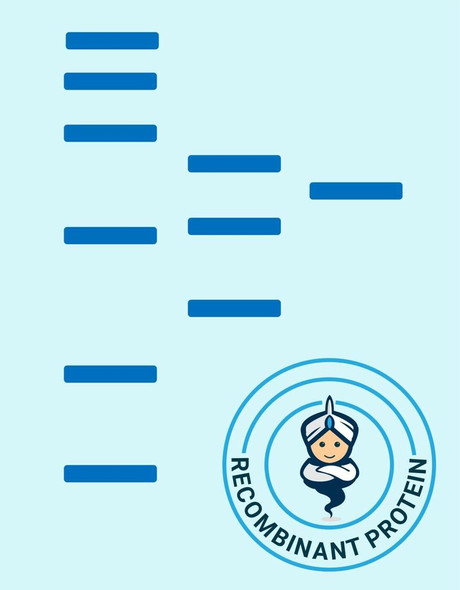Description
| Product Name: | Human DNAL1 Recombinant Protein |
| Product Code: | RPPB3364 |
| Size: | 20µg |
| Species: | Human |
| Target: | DNAL1 |
| Synonyms: | Dynein light chain 1, axonemal, C14orf168, CILD16, DNAL1. |
| Source: | Escherichia Coli |
| Physical Appearance: | Sterile Filtered colorless solution. |
| Formulation: | The DNAL1 solution (1mg/1ml) contains 20mM Tris-HCl buffer (pH 8.0), 0.4M Urea and 10% glycerol. |
| Stability: | Store at 4°C if entire vial will be used within 2-4 weeks. Store, frozen at -20°C for longer periods of time. For long term storage it is recommended to add a carrier protein (0.1% HSA or BSA).Avoid multiple freeze-thaw cycles. |
| Purity: | Greater than 90% as determined by SDS-PAGE. |
| Amino Acid Sequence: | MGSSHHHHHH SSGLVPRGSH MGSMAKATTI KEALARWEEK TGQRPSEAKE IKLYAQIPPI EKMDASLSML ANCEKLSLST NCIEKIANLN GLKNLRILSL GRNNIKNLNG LEAVGDTLEE LWISYNFIEK LKGIHIMKKL KILYMSNNLV KDWAEFVKLA ELPCLEDLVF VGNPLEEKHS AENNWIEEAT KRVPKLKKLD GTPVIKGDEE EDN |
Dynein Axonemal Light Chain 1 (DNAL1) functions as a component of the outer dynein arms complex. DNAL1 acts as the molecular motor which supplies the force to move cilia in an ATP-dependent manner. DNAL1 is expressed in tissues with motile cilia or flagella and takes part in the movement of sperm flagella. Alternate splicing results in numerous transcript variants.
DNAL1 Human Recombinant produced in E. coli is a single polypeptide chain containing 213 amino acids (1-190) and having a molecular mass of 23.9 kDa. DNAL1 is fused to a 23 amino acid His-tag at N-terminus & purified by proprietary chromatographic techniques.
| UniProt Protein Function: | DNAL1: Defects in DNAL1 are the cause of primary ciliary dyskinesia type 16 (CILD16). A disorder characterized by abnormalities of motile cilia. Respiratory infections leading to chronic inflammation and bronchiectasis are recurrent, due to defects in the respiratory cilia; reduced fertility is often observed in male patients due to abnormalities of sperm tails. Half of the patients exhibit randomization of left-right body asymmetry and situs inversus, due to dysfunction of monocilia at the embryonic node. Primary ciliary dyskinesia associated with situs inversus is referred to as Kartagener syndrome. Belongs to the dynein light chain LC1-type family. 3 isoforms of the human protein are produced by alternative splicing. |
| UniProt Protein Details: | Chromosomal Location of Human Ortholog: 14q24.3 Disease: Ciliary Dyskinesia, Primary, 16 |
| NCBI Summary: | This gene encodes an axonemal dynein light chain which functions as a component of the outer dynein arms complex. This complex acts as the molecular motor that provides the force to move cilia in an ATP-dependent manner. The encoded protein is expressed in tissues with motile cilia or flagella and may be involved in the movement of sperm flagella. Alternate splicing results in multiple transcript variants.[provided by RefSeq, Jan 2011] |
| UniProt Code: | Q4LDG9 |
| NCBI GenInfo Identifier: | 121944344 |
| NCBI Gene ID: | 83544 |
| NCBI Accession: | Q4LDG9.1 |
| UniProt Secondary Accession: | Q4LDG9,Q5JPB7, Q9BS43, B2RD38, |
| UniProt Related Accession: | Q4LDG9 |
| Molecular Weight: | 22kDa |
| NCBI Full Name: | Dynein light chain 1, axonemal |
| NCBI Synonym Full Names: | dynein axonemal light chain 1 |
| NCBI Official Symbol: | DNAL1�� |
| NCBI Official Synonym Symbols: | CILD16; C14orf168�� |
| NCBI Protein Information: | dynein light chain 1, axonemal |
| UniProt Protein Name: | Dynein light chain 1, axonemal |
| Protein Family: | Dynein |
| UniProt Gene Name: | DNAL1�� |






